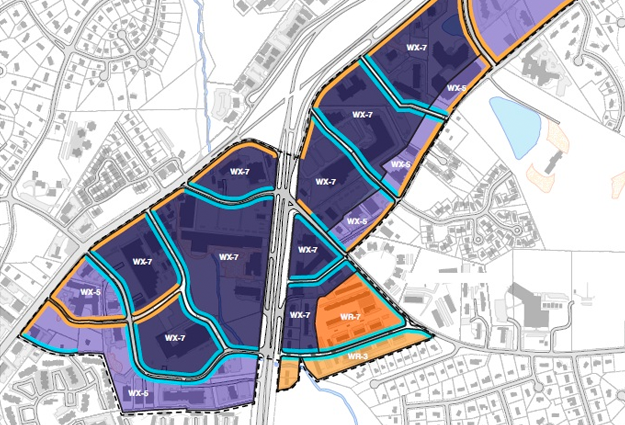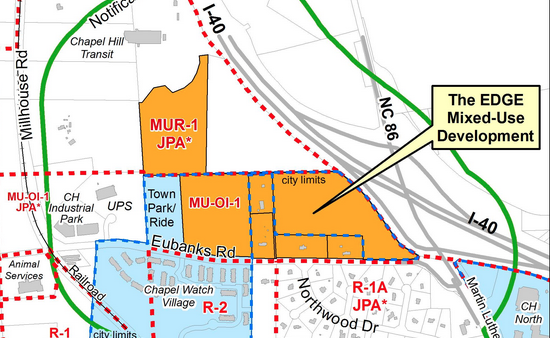The Chapel Hill Town Council took a series of votes Monday night to adopt a new type of zoning known as form-based code and apply it to a large swath of land surrounding the Ephesus Church Road-Fordham Boulevard intersection.
Council member George Cianciolo sided with the majority in supporting the plan.
“I do believe that this will be successful for Chapel Hill,” Cianciolo told the crowd of more that one hundred who turned out for the third public hearing on the proposal. “That’s what I was elected to do, use my best judgement.”
The Council voted 8-1 to adopt the new form-based code into the town land use plan, and 6-9 to apply it to the majority of the 190 acre Ephesus-Fordham focus area. Ed Harrison, Matt Czajkowski and Jim Ward voted against the rezonings.
The plan calls for the town to reconfigure the intersection of Ephesus Church Road and Fordham Boulevard, extend Elliot Road and create new mixed-use zones that allow three to seven stories of commercial and residential development.
Supporters say it will encourage new business growth in the area while also addressing long-standing flooding problems and traffic jams.
However, opponents have raised doubts about the efficacy of the stormwater management plan and questioned the cost and timing of the redevelopment proposal. Council member Czajkowski sided with critics of the plan.
“There’s no evidence that it will achieve the original goals, including stormwater, including traffic mitigation, including increasing commercial tax revenue towards the town,” said Czajkowski.
Council member Ward opposed the plan because he said switching from a Special Use Permit approval process to form-based code means the Council will lose the chance to negotiate with developers for affordable housing and energy efficient design.
“Sounds like the rest of the Council is ready to give away the store in terms of the one thing that we have, and that’s the ability to offer greater density as an incentive,” said Ward. “It baffles me.”
Using form-based code, the Council sets parameters for development including building height, setbacks and parking guidelines for each zone, but once these are in place, individual developers will not need to bring their projects before the council if they meet the established criteria. Instead, projects will be reviewed by the Town Manager and the Community Design Commission. Council members expressed interest in reviewing the first projects that come forward under the new guidelines, but they will not be able to ask developers for concessions.
Mayor pro Tem Sally Greene proposed holding off on rezoning four parcels of land along Elliot Road from East Franklin Street to Fordham Boulevard while staffers investigate the possibility of offering density bonuses for developers who build affordable housing.
“What I’m talking about is a proposal that would change properties 1, 2, 3 and 4 from WX 5 to WX 2, as in two stories permitted by right with a density bonus of five stories in exchange for 10 percent affordable housing,” said Greene.
The Council backed her proposal, leaving the land as-is for now.
In addition, the Council voted unanimously to rezone 8.5 acres on Legion Road so that nonprofit developer DHIC can apply for low-income tax credits to subsidize a proposed affordable rental housing project on the site. The town is partnering with DHIC on the project, but some backers worried the rezoning might not happen before Friday’s deadline to apply for tax credits.
While the zoning is now in place, the town is still in the process of figuring out how to pay for the $10 million dollars worth of infrastructure improvements. To that end, the town is asking Orange County to help pay down the town’s debt by contributing a portion of the increased tax revenues the redevelopment is expected to generate.
County commissioners will consider that plan on Thursday night.






Comments on Chapelboro are moderated according to our Community Guidelines